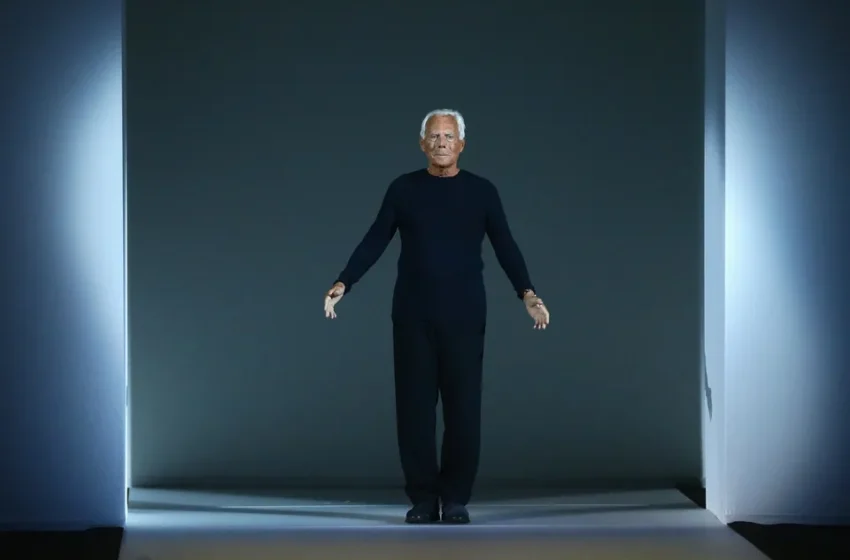Giorgio Armani: From medicine and military duty to maestro of modern fashion

Late Italian fashion designer, Giorgio Armani. Photo Credit- Bloomberg
The world of fashion is draped in mourning as Giorgio Armani, the Italian visionary who redefined elegance with his unstructured tailoring and quiet sophistication, has died at the age of 91. Armani’s house confirmed he passed peacefully at home, having recently sat out the June shows while recovering from illness. His departure marks the end of an era in which he not only dressed the world but reshaped its idea of style.
What makes Armani’s life story even more extraordinary is that his path to fashion began nowhere near the ateliers of Milan or Paris. Few know that the man who would become synonymous with understated glamour first set his sights on medicine. Born in Piacenza in 1934, Armani initially pursued a degree in medicine at the University of Milan, drawn by curiosity and a desire to serve. Yet, amid anatomy lectures and long nights of study, he discovered a gnawing absence of passion. His heart was not in diagnosing illness; instead, he was quietly drawn to the textures of life that existed beyond the sterile halls of a hospital.
READ ALSO
Giorgio Armani dies at 91: What to know about iconic Italian fashion designer
His medical studies were cut short when he was conscripted into military service, a common fate for young Italian men of his generation. Armani served diligently, but the military, with its rigid uniforms and strict codes of order, became a strange, unintentional classroom for him. It exposed him to the power of clothing not just as protection, but as identity and authority. The very fabrics, lines, and fits of uniforms stayed etched in his memory, and in hindsight, this period planted subtle seeds for the designer he would become.
After his military stint, Armani did not march straight into fashion stardom. His entry was modest, almost accidental. He began as a window dresser for the Milan department store La Rinascente. Here, he learned the delicate art of presentation—how to capture attention with a mannequin’s posture, how lighting could make a garment sing, how colors could whisper luxury. Later, he worked as a buyer, traveling abroad and encountering global styles, gaining an education that no university could have offered.
By the 1960s, Armani was designing for Nino Cerruti’s menswear line, sharpening his skills and quietly developing a design philosophy that would one day revolutionize modern fashion. He stripped away the stiff padding and rigid structures that dominated men’s tailoring, replacing them with fluidity and comfort. His suits moved with the body rather than against it, exuding confidence without excess. This was unstructured elegance, a style philosophy that would soon become his signature.
The 1970s marked Armani’s breakthrough. In 1975, alongside his lifelong partner Sergio Galeotti, he founded his own label. His early collections spoke a new language of fashion—soft, relaxed, yet undeniably luxurious. By the 1980s, Armani’s power suits had stormed Hollywood and Wall Street, becoming the unofficial uniform of actors, executives, and anyone who wanted to project effortless authority. Richard Gere in American Gigolo, draped in Armani, became an indelible pop culture image of this revolution.
Beyond tailoring, Armani expanded his empire into womenswear, fragrance, accessories, interior design, and even hospitality, each extension carrying the same DNA of quiet luxury. Unlike flamboyant designers who thrived on spectacle, Armani’s magic was restraint. He understood that true elegance whispers; it does not shout. His clothes allowed the wearer to shine, rather than being overshadowed by them.
Yet Armani’s legacy goes deeper than fabric. He became a symbol of Italian craftsmanship, building one of the most financially independent and enduring fashion houses in the world, entirely privately owned. He embodied discipline, vision, and an almost ascetic devotion to his craft. For decades, he resisted selling out to conglomerates, ensuring his brand remained synonymous with his values.
Now, as the world bids farewell to Giorgio Armani, we remember not only the sleek lines of his jackets or the way his suits moved across red carpets, but also the improbable journey that brought him here. From a young medical student and soldier to a master tailor of global renown, Armani’s story reminds us that greatness often emerges from unexpected beginnings.
He leaves behind more than a fashion house; he leaves a philosophy of elegance that transcends seasons, trends, and time. At 91, Giorgio Armani has taken his final bow, but the world will forever walk in the silhouette he sketched into history.



